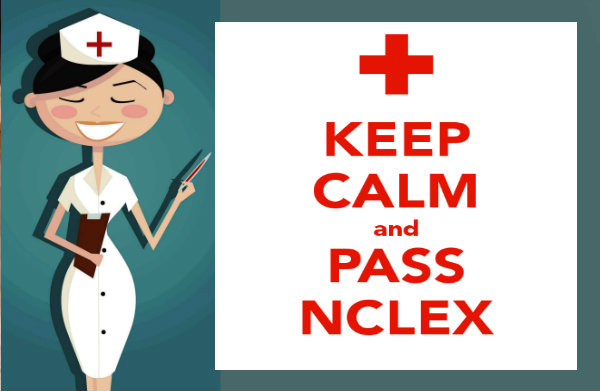1. A 68-year-old woman is diagnosed with thrombocytopenia due to acute lymphocytic leukemia. She is admitted to the hospital for treatment. The nurse should assign the patient:
a. to a private room so she will not infect other patients and health care workers.
b. to a private room so she will not be infected by other patients and health care workers.
c. to a semiprivate room so she will have stimulation during her hospitalization.
d. to a semiprivate room so she will have the opportunity to express her feelings about her illness.
2. While inserting a nasogastric tube, the nurse should use which of the following protective measures?
a. Gloves, gown, goggles, and surgical cap.
b. Sterile gloves, mask, plastic bags, and gown.
c. Gloves, gown, mask, and goggles.
d. Double gloves, goggles, mask, and surgical cap.
3. A nursing team consists of an RN, an LPN/LVN, and a nursing assistant. The nurse should assign which of the following patients to the LPN/LVN?
a. A 72-year-old patient with diabetes who requires a dressing change for a stasis ulcer.
b. A 42-year-old patient with cancer of the bone complaining of pain.
c. A 55-year-old patient with terminal cancer being transferred to hospice home care.
d. A 23-year-old patient with a fracture of the right leg who asks to use the urinal.
4. Which of the following ethnic groups is at higher risk for pesticide-related injury?
a. Native American
b. Asian-Pacific
c. Norwegian
d. Hispanic
5. The patient has sustained a hyphema, what intervention should nurse Adrian take?
a. Have client wear ear protectors in the future
b. Keep the client at bed rest typically with head of bed up
c. Apply atropine eye drops
d. Apply an ice pack to the site of injury
6. While repositioning a comatose client, nurse Alexandra senses a tingling sensation as she lowers the bed. What action should she take?
a. Unplug the bed’s power source
b. Remove the client from the bed immediately
c. Notify the biomedical department at once
d. Turn off the oxygen
7. During a well infant check-up, the RN notes a religious amulet around the client’s neck. What is the best response to the caregiver?
a. Can you tell me about the necklace?
b. This is a choking hazard
c. Let me get this off
d. Why did you put this around the baby’s neck?
8. A lifeless child is brought unconscious to ER with resuscitative efforts in progress. In considering the etiology of childhood deaths, which of the following is the most likely cause?
a. Poisoning
b. congenital defects
c. accidents
d. Influenza
9. While eating in the hospital cafeteria, nurse Carol sees a visitor display the “universal sign of choking.” Her first action is:
a. page a “Code Blue” emergency
b. immediately perform the Heimlich maneuver
c. assess for ineffective breathing by asking, “Are you choking
d. deliver four sharp back blows between the scapulae
10. Nurse Lizzie teaching a parenting class instructs that the hot water temperature in the home should be at what degree to prevent thermal burns?
a. 100ºF
b. 120ºF
c. 140ºF
d. 150ºF
11. Community accident prevention education will include which of the following facts regarding the most prevalent cause of accidental death from age 1-44?
a. Drowning
b. Burns
c. motor vehicle accidents
d. Firearms
12. The Client Self-Determination Act of 1990 requires all hospitals to inform clients of advance directives. What should nurse Byron tell the client about such advance directives as living wills and health care power of attorney?
a. They guide the client’s treatment in certain health care situations
b. They can’t provide do-not-resuscitate (DNR) orders for clients with terminal illnesses
c. They allow physicians to make decisions about treatment
d. They permit physicians to give verbal DNR orders
13. A client who agreed to become an organ donor is pronounced dead. What is the most important factor in selecting a transplant recipient?
a. Blood relationship
b. Sex and size
c. Compatible blood and tissue types
d. Need
14. Nurse Calvin receives a medication order over the telephone. How should the nurse handle this situation?
a. Tell the physician that the nurse practice act prohibits taking medication orders over the telephone
b. Verify the order by repeating it over the phone
c. Request that a second physician repeat the order to the nurse over the telephone
d. Insist that the physician sign the medication order within 1 hour
15. Emergency restraints or seclusion may be implemented without a physician’s order under which of the following conditions?
a. When a written order will be obtained from the primary physician within 8 hours
b. Never
c. If a voluntary client wants to leave against medical advice
d. When a minor child is out of control
16. Nurse Elle is concerned about another nurse’s relationship with the members of a family and their ill preschooler. Which of the following behaviors would be most worrisome and should be brought to the attention of the nurse-manager?
a. The nurse keeps communication channels open among herself, the family, physicians, and other health care providers.
b. The nurse attempts to influence the family’s decisions by presenting her own thoughts and opinions.
c. The nurse works with the family members to find ways to decrease their dependence on health care providers.
d. The nurse has developed teaching skills to instruct the family members so they can accomplish tasks independently.
17. The basis for building a strong therapeutic nurse-client relationship begins with the nurse’s:
a. sincere desire to help others
b. acceptance of others
c. self-awareness and understanding
d. sound knowledge of psychiatric nursing
18. A man found wandering in a local park is unable to state who or where he is or where he lives. He is brought to the emergency department, where his identification is eventually discovered. The client’s wife states that he was diagnosed with Alzheimer’s disease 3 years ago and has had increasing memory loss. She tells the nurse she is worried about how she’ll continue to care for him. Which response by the nurse would be most helpful?
a. Because of the nature of your husband’s disease, you should start looking into nursing homes for him
b. What aspect of caring for your husband is causing you the greatest concern?
c. You may benefit from a support group called Mates of Alzheimer’s Disease Clients
d. Do you have any children or friends who could give you a break from his care every now and then?
19. Nurse Beth is caring for a client with hyperemesis gravidarum who will need close monitoring at home. When should the nurse begin discharge planning?
a. On the day of discharge
b. When the client expresses readiness to learn
c. When the client’s vomiting has stopped
d. On admission to the facility
20. A client is being discharged after undergoing abdominal surgery and colostomy formation to treat colon cancer. Which nursing action is most likely to promote continuity of care?
a. Notifying the American Cancer Society of the client’s diagnosis
b. Requesting Meals On Wheels to provide adequate nutritional intake
c. Referring the client to a home health nurse for follow-up visits to provide colostomy care
d. Asking an occupational therapist to evaluate the client at home
21. A client requests his medication at 9 p.m. instead of 10 p.m. so that he can go to sleep earlier. Which type of nursing intervention is required?
a. Intradependent
b. Interdependent
c. Dependent
d. Independent
22. A family member visiting on an acute care psychiatric unit approaches the nurse’s station and reports that an elderly client is walking in the hall without her clothing. Nurse Casper doesn’t assist the client and suggests that the family member inform the nurse assigned to that client. Which of the following terms describes the nurse’s action?
a. Negligent
b. Sensitive
c. Compassionate
d. Organized
23. An agitated client demands to see her chart so she can read what has been written about her. Which of the following statements is nurse Cedric best response to the client?
a. I’m sorry the chart is the property of the facility. We don’t permit clients to read them
b. You have the right to see your chart. Please discuss this with your primary care provider
c. You may see your chart after you’re discharged
d. Please discuss this matter with your attorney
24. Nurse Chuck is caring for a school-age child with cerebral palsy. The child has difficulty eating using regular utensils and requires a lot of assistance. Which of the following referrals is most appropriate?
a. Registered dietitian
b. Physical therapist
c. Occupational therapist
d. Nursing assistant
25. Nurse Sylvia manages a unit that has four full-time vacant positions, and nurses volunteer to work extra shifts to cover the staffing shortages. One of the staff nurses hasn’t volunteered and states, “Forty hours a week of nursing is all I can manage to do. I won’t volunteer for overtime.” The nurse-manager says to an attending physician on the unit, “I’ll adjust her schedule to make her wish she’d volunteered.” The physician to whom she commented should:
a. choose to ignore the comment because it isn’t the physician’s domain
b. report the nurse-manager to the labor relations board
c. ensure that the nurse-manager receives counseling about her comment
d. tell the staff nurse what the manager said about her
More NCLEX Questions:
NCLEX-RN Practice Questions (Part 2)
NCLEX-RN Practice Questions (Part 3)
NCLEX-RN Practice Questions (Part 4)









![Are You Ready For An Online Nursing Program? [Infographic] online nursing program requirements and benefits](https://www.nursebuff.com/wp-content/uploads/2013/09/online-nursing-program-requirements-and-benefits2-100x70.jpg)









